Bryant T2-NHP01-A Non- Programmable Thermostat

YOU WILL LOVE THIS THERMOSTAT
This Legacytnon- programmable thermostat is an easy-to-use model that provides the most sought-after features for keeping your home comfortable. And with a slim profile, it is designed to be as smart – and smart- looking as any of the other electronics in your home. Let this manual show you how easy it is to enjoy the newest experience in home comfort.
NOTE: Read the entire instruction manual before starting the installation.
BUTTON IDENTIFICATION
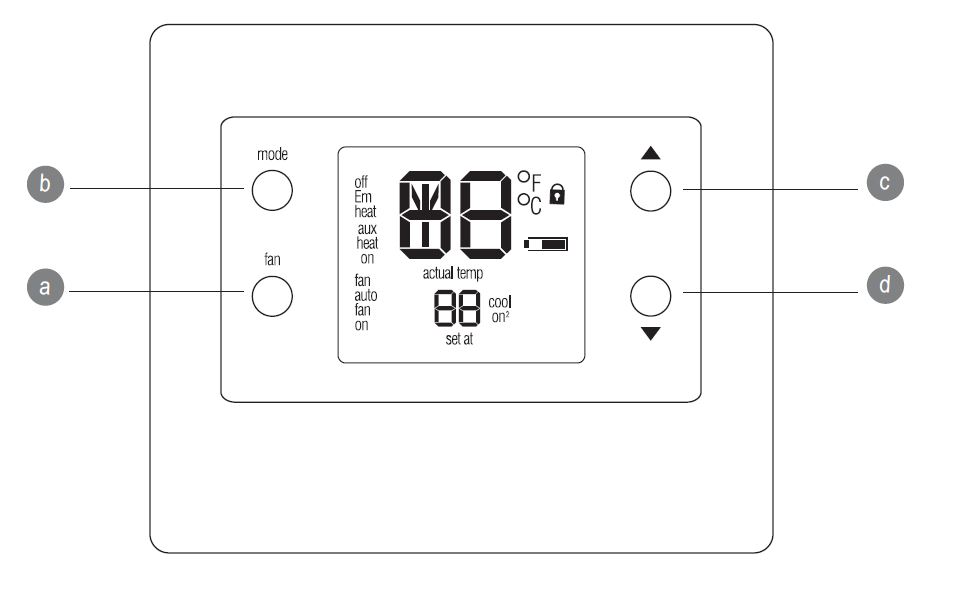
BUTTON IDENTIFICATION
- FAN Selects whether the fan operates continuously (on) or only when needed for heating or cooling (auto)
- MODE Selects whether the thermostat is set for heating, cooling, emergency heat (heat pump system only), auto (heat and cool as needed), or off
- UP Increases the temperature or adjusts the screen selection up when setting advanced features
- DOWN Decreases the temperature or adjusts the screen selection down when setting advanced features
ON- SCREEN INDICATORS
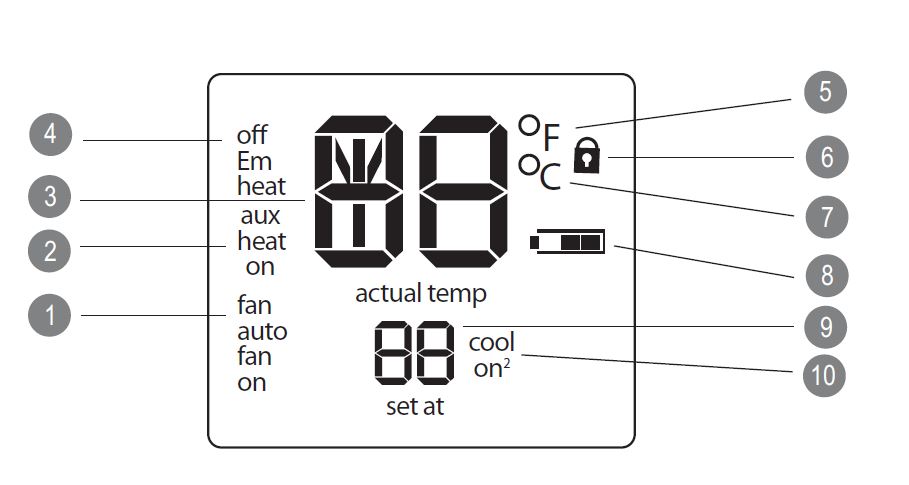
ON- SCREEN INDICATORS
- Fan mode – on or auto
- The system is in auxiliary (supplemental) mode
- Current temperature
- The thermostat mode is either off or using emergency heat
- Fahrenheit
- Keypad is locked (no padlock means unlocked)
- Celsius
- Battery strength indicator
- Selected cooling set point; “on” indicates the system is in cooling mode
- The second stage of cooling is active
OPERATING THE THERMOSTAT
Setting the temperatures for heating and cooling Your thermostat is installed with the heating set at 68 F and the cooling set at 72 F. You can use these or change them so your home is as warm or as cool as you would like it to be. These steps will hold the temperature where you set it.
- To change the heating temperature, press the mode button on the left until the screen says heat.
- Press the up or down button located on the right side of the display until you reach the desired temperature.
- To change the cooling temperature, press the mode button on the left until the screen says coolly.
- Press the up or down button located on the right side of the display until you reach the desired temperature
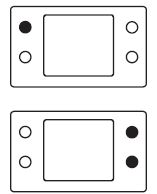
Using the fan
When the fan is on, it helps distribute air throughout your home for a more even temperature in all spaces. You can set the thermostat so that the fan runs only during your heating and cooling cycles (auto mode) or runs continuously.
The thermostat is set at the factory to run automatically as needed. Here’s how to change the setting so it runs continuously.
- Press the fan button on the left. The display message will change from auto fan to fan on.
- To return the fan to auto mode, press the fan button again. You will see an auto on the display.

Using emergency heat (heat pump systems only)
Emergency heat is useful when the automatic auxiliary heat system can’t keep up with demand. (Systems with heat pumps use “auxiliary heat” when it’s too cold outside for the heat pump to heat the house without help. The display indicator for
this is aux heat on.) If the heat pump compressor that works with auxiliary heat fails, or if the heat pump isn’t working at all, you can turn on the emergency heat for that extra help. (You’ll know there’s a problem if the house can’t seem to get warm when it’s very cold outside.) You want to avoid using emergency heat, though, because it’s the most expensive option. And, of course, if you suspect a problem with your heat pump, call your heating and cooling dealer immediately.
Here’s how to set your thermostat to use emergency heat.
- Press the mode button repeatedly until you see Em heat in the upper left of the display.
- To turn off the emergency heat, press the mode button again to select heat, cool or auto.

Installing or replacing the batteries
You can install batteries in your thermostat so that if the power goes out, the display will still show the indoor temperature. In some situations, batteries are also the power source. Then, two AA batteries should last about one year. When the batteries have lost about one-third of their power, a battery icon appears on the display. Two-thirds of it will be black. As the batteries get weaker, the icon goes down to one black bar and then none. When the icon is empty, you will begin to lose thermostat functions when it is battery-powered. When the batteries are completely dead, you won’t be able to use the thermostat. When using batteries for power, we recommend that you replace the batteries at the one-bar level with two AA alkaline batteries. They’re in the back of the thermostat, so you’ll have to remove it from the wall. Here’s how to both install and replace batteries.
- Locate the latch at the top of the thermostat. It’s at the center of the top rim.
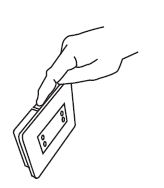
- Press it down. This will disconnect the thermostat from the top of the wall plate.
- Remove the thermostat from the wall bracket completely by bringing it slightly toward you and lifting it up and off the lip on the lower edge of the wall bracket.
- Set the thermostat face down on a flat surface. You will see the batteries in the lower right corner.
- Remove and discard or recycle the old batteries.
- Install new batteries by matching the “plus” and “minus” ends of the batteries with the “plus” and “minus” indicators you’ll see outside the two white battery shapes in the space where the batteries sit.
- Snap the batteries into place.
- out the thermostat back on the wall bracket by lining up the slot on the bottom edge of the back of the thermostat with the lip on the wall bracket. You will feel the slot fit over the lip.
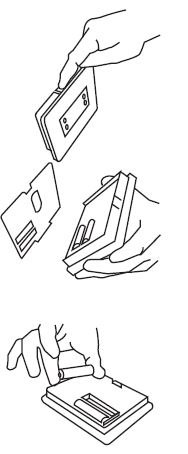
- With the bottom of the thermostat attached to the bottom of the wall bracket, bring the thermostat back to the wall. Line up the latch at the top of the thermostat with the corresponding lip on the wall bracket.
- Lightly push the thermostat toward the wall. When the latch and lip are lined up properly, you will hear the thermostat snap into place.
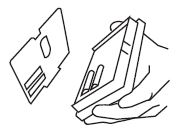
Using the thermostat to turn the heating and cooling system off
To use the thermostat to turn the heating and cooling system off, press the mode button on the left repeatedly until the display shows off in the upper left.

Auto changeover
The thermostat uses one of five modes: heat, cool, Em heat (heat pump version only), auto, and off. When the mode selection is auto, the thermostat is in auto changeover mode. This allows the system to switch from heating to cooling – or from cooling to heating – to maintain the temperatures you’ve set. It does this automatically.
ADVANCED OPTIONS
Advanced options display codes chart You can customize a few features of your thermostat. This chart shows which features you can change and the codes associated with them. The codes will be shown on the display when you follow the instructions.
| Feature | Configuration Code | Change Indication |
| Fahrenheit to Celsius | U1 | F or C |
| backlighting | U2 | On or Of |
| keypad lockout | U3 | Of, On, padlock |
Changing from Fahrenheit to Celsius
Your thermostat is preset to display the temperature in degrees Fahrenheit. You can change this to Celsius.
- Press and hold the mode button for about three seconds. The display will show U1 and the letter F in the center.
- Press the up or down button on the right to change it from F (Fahrenheit) to C (Celsius).
- Press the fan button on the left to exit this screen
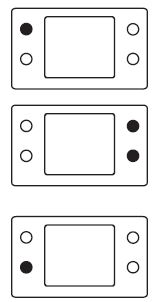
Turning on the continuous backlighting
The thermostat display lights up for a few seconds after you press any button. This is backlighting. It will go dark after a few seconds. If the thermostat is powered by electricity, it is possible to have a constant low-level amount of backlighting until you press any button, which increases the lighting temporarily. Here’s how to turn on the constant backlight when your thermostat is powered by electricity.
- Press and hold the mode button for about three seconds. The display will show U1 and the letter F in the center.
- Press the mode button twice. The display will show U2 and Off.
- Press the up or down button on the right to change it from Off to On.
- Press the fan button on the left to exit this screen.
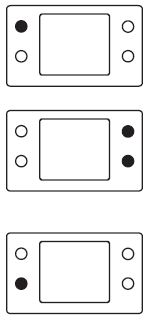
Keypad lockout
The keypad lockout feature lets you “lock” the thermostat so nobody can change the temperature – or make any other changes – by pressing buttons. Keypad lockout is not activated when the thermostat is installed. Here’s how to activate it.
- Press and hold the mode button for about three seconds. The display will show U1 and the letter F in the center.
- Press the mode button until the display shows U3 and Of.
- Press the up or down button on the right to change it from Of to On. You will also see a padlock, which indicates
- Press the fan button on the left to exit this screen.
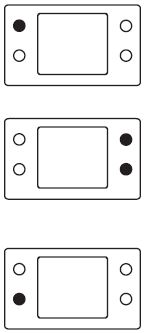
Unlocking the keypad
Here’s how to temporarily unlock the keypad.
- Press and hold the up and down buttons on the right simultaneously for about five seconds.
- The padlock icon will disappear. This means the keypad is unlocked and can be used. The keypad will revert back to the locked state after you’ve stopped pushing buttons for two minutes.

WHAT IF . . .
The battery icon is displayed
The battery icon appears on the display only when the battery starts to lose power. Replace it when one-third of the icon is black. If your thermostat is battery-powered and you wait until the icon is just a silhouette with no black bars, you will
slowly lose thermostat functions until it doesn’t work at all.
“Aux heat on” is displayed (heat pump systems only)
Aux heat on is auxiliary heat. It applies only to the heat pump version. If it is on, you will see the aux heat on. When it is displayed, it means the system has determined that it’s too cold outside for your heat pump to heat the house without help, so it’s getting help from the electric heaters. This happens automatically.
“Em heat” is displayed (heat pump systems only)
Em heat is the display term for emergency heat and applies only to the heat pump version. You have to turn on emergency heat manually – it doesn’t happen automatically – so if you see Em heat on the display, it means somebody has turned it on.
There is a power outage
If you lose electricity and have batteries installed, the thermostat will continue to display the indoor temperature because it has a battery backup power source. This means that even though your heating and cooling system doesn’t work, you will still be able to monitor your home’s temperature.
You get a system error message
Here are the possible system error messages and what they mean: The room air sensor reports that the room air temperature is above 150 or below – 50 E4 The memory has failed and the thermostat will return to the default factory settings. Call your heating and cooling dealer.
COMMON TERMS AND WHERE TO FIND THEM
Auto changeover . . . . . . . . . . . . . . . . . . . . . . . . . . . . . . . . . . . . . . . . . . page 14
This feature automatically switches your system from heating to cooling – or from
cooling to heating – whenever necessary.
Auxiliary heat (heat pump systems only) . . . . . . . . . . . . . . . . . . . . page 10
Most heat pump systems can’t heat a home sufficiently when it gets very cold outside so they use a supplemental heating source called auxiliary heat. The system knows when to use this help and does so automatically. If it’s using auxiliary heat,
the display will show aux heat on. You have no control over the auxiliary heat function.
Backlighting . . . . . . . . . . . . . . . . . . . . . . . . . . . . . . . . . . . . . . . . . . . . . . page 17
Backlighting illuminates your display when you push a button.
Emergency heat (heat pump systems only) . . . . . . . . . . . . . . . . . . page 10
You can manually set the thermostat to use emergency heat but it is the most expensive option. If it’s using emergency heat, the display will show Em heat.
Mode . . . . . . . . . . . . . . . . . . . . . . . . . . . . . . . . . . . . . . . . . . . . . . . . . . . . page 14
This term refers to the type of operation your system is performing. The options are heat, cool, emergency heat, auto, and off.
The manufacturer reserves the right to change, at any time, specifications and designs without notice and without obligations.
REFERENCE:
Download Manual:
Bryant T2-NHP01-A Non- Programmable Thermostat Owner Manual

Bryant T2-NHP01-A Non- Programmable Thermostat Owner Manual
The post Bryant T2-NHP01-A Non- Programmable Thermostat Owner Manual appeared first on thermostat.guide.
source https://thermostat.guide/bryant/bryant-t2-nhp01-a-non-programmable-thermostat-owner-manual/
No comments:
Post a Comment